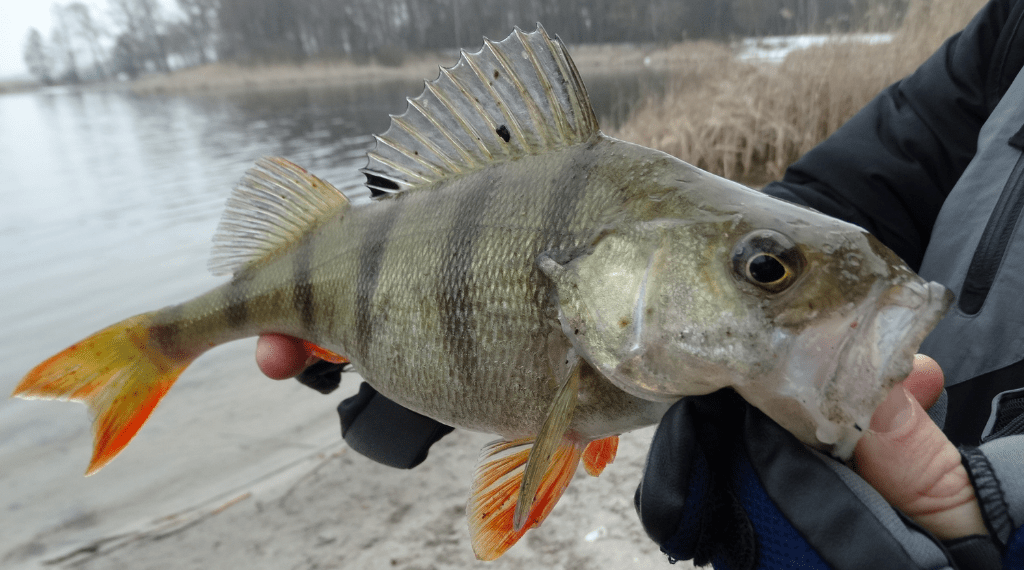Do you want to learn how to catch perch?
Great, you’ve come to the right place. We’re here to help.
In this article, you’ll learn all about the best tips and techniques for catching these tasty panfish. We’ll cover things like where to go fishing for perch, bait, lures, and even how to catch perch ice fishing.
So whether you’re a beginner or an expert angler, there are plenty of helpful tips below that will help increase your catch when going perch fishing.
All About Perch
Even though there are many different types of perch, it is the yellow perch (Perca falvescens) that is sort after by most anglers in North America.
Yellow perch are freshwater fish common in Europe, North America, and northern Asia. They come out of hiding at dusk to eat aquatic insects, worms, snails, sponges, crustaceans, and small fish.
These panfish are sometimes confused with zander, which is not native fish in areas outside Europe. Zander is not only bigger than yellow perch but also has a thicker body. Their mouths are less upturned, and they have no scales on their bellies.
Perch thrive in lakes, rivers, ponds, and reservoirs. But are very sensitive to pollution, so you can actually use them as an environmental indicator. They like clear water and good cover, such as weeds or overhanging trees.
Where to go Fishing for Perch
If you want to learn how to catch yellow perch, you need to be familiar with the places and conditions they like to hang out in.
If you live near a stream or river, look for fallen trees and branches to provide extra cover. These spots often have smaller fish around them called “feeders,” feeding on insects living among the debris. That makes them an easy target for bigger fish like yellow perch. The larger the feeder, the bigger the chance there are also bigger fish nearby, so be ready!
River perch (the largest freshwater species) typically live near the bottom. They don’t go into open water unless forced to by high water levels. They prefer calm or slow-moving parts of rivers or lakes with lots of weeds growing on the bottom where they can hide from predators. This also makes them easier to catch for anglers.
Yellow perch prefer lively areas. Such as rocky depths, underwater obstructions, currents, etc. The keyword here is “lively”. They don’t like dead or still water at all.
A good technique that works well is looking for bird nests near the water’s edge – Perch often feed on the same type of insects as certain species of birds.
Another good way to find a place with lots of fish is to look for shaded areas – Perch love the shade and stay there during the warmest parts of the day. They will gather under fallen trees or other natural cover types such as large rocks in slow-moving rivers. In lakes, it’s all about weed beds, logs, or lily pads.
Other good spots for catching perch include dams or weirs, but they migrate depending on water level, so this isn’t reliable. Lakes with lots of weed beds are perfect for fishing. Smaller perch often live in streams even if there is a lake nearby. So it’s always worth trying further upstream where the flow is less fast-moving. Natural obstacles such as rocks or fallen trees can also attract them to specific areas.
What Bait to use for Perch
You can use many different baits to catch perch. The three most popular baits are minnows, small worms, and dough balls. These baits will also catch trout, bass, bluegill, and catfish.
When learning how to catch perch, the best bait to use is a minnow; Yellow perch love these fishy snacks. You can catch minnows in any clear or murky water sources nearby. But, check the local rules before using this bait because it is not legal to use it without consent in many areas. It is also possible to catch minnows with a trap which you can set up at night.
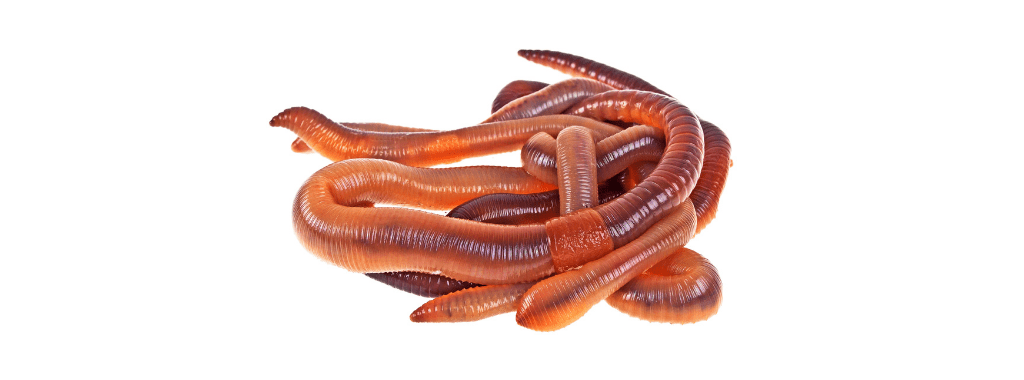
Small worms are a popular bait for perch fishing because they are relatively cheap and easy to find. To use a small worm, cast it out on your line very close to where you would cast out a minnow. Don’t cast too far to avoid it getting ripped away from the hook by any current pushing against it.
Another way of catching smaller worms is to dig around under rocks or pebbles with your bare hands until you find one. Then grab it and put it into a jar or plastic bag filled with water from the river or lake.
Dough balls are also very effective for catching yellow perch. You can find recipes to make your dough on the Internet, or you can buy some premade dough at the store.
Put about 1/4 cup of dough in a bowl and add water to form a pliable ball (don’t put too much water because it will dissolve into the fish while you’re fishing).
This bait is excellent because it smells like food, attracts other fish that will try to steal it from the Perch. It doesn’t dissolve easily in the water like many different baits.
You can use many other baits to catch yellow perch. Some additional tricks include crappie bait, nuts and berries, cheese, bread balls, chicken livers, and many more.
The perch you can catch ranges from 3 to 20 inches long. If using live bait, use tube baits or Gulp Minnows, small shiners between 4-6 inches long work best. You’ll want a little bigger for wintertime fishing – up to 7/8 inch in length.
Bigger baits work better on big perch. You can also use cut bait like crappies and bluegills; chubs are also suitable for this type of fishing.
To learn more about baits to catch big perch check out this video.
How do you rig for Perch Fishing
Rigging is one of the essential steps when catching any fish. It determines the depth at which you are fishing, it sets how tight or loose your line is when setting the hook, and if done wrong, it can mean no bite. The yellow perch is not an exception when it comes to the need for proper rigging.
So here are a few tips on how to rig up your tackle for catching perch:
Slip Bobber Rig
A slip bobber enables you to target fish at specific depths. This is useful when targeting perch as they will often school at specific depths. If your bait is too high or too low in the water column you will miss the strike zone.
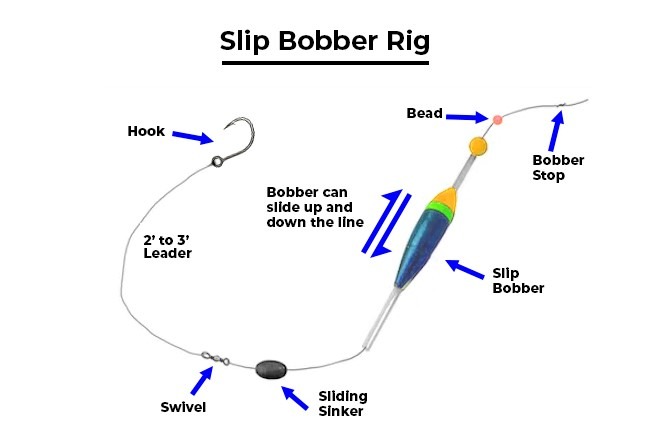
What size hook is best for Perch
Perch have hard small mouths with no teeth, so you need sharp hooks. Because of their small mouths, #2 to #6 hooks work best for perch fishing.
Use J-hook style setups. If you are using smaller baits between 1 and 2 inches go for a #4 or #6 size hook. If you are planning to target larger jumbo perch that need larger baits then you will want to use a #2 size hook.
Sinkers
Use an egg sinker or pyramid sinker depending on water depth and current speed. A 3-4 inch (7-10cm) leader is exemplary, but longer ones (12 inches and more) are not a bad idea if the water is deep.
What Lures to use for Perch
Perch is a species that responds to small lures very well. The most typical attractions are spinners, spoons, and plugs. These lures will create vibrations in the water that trigger yellow perch into eating.
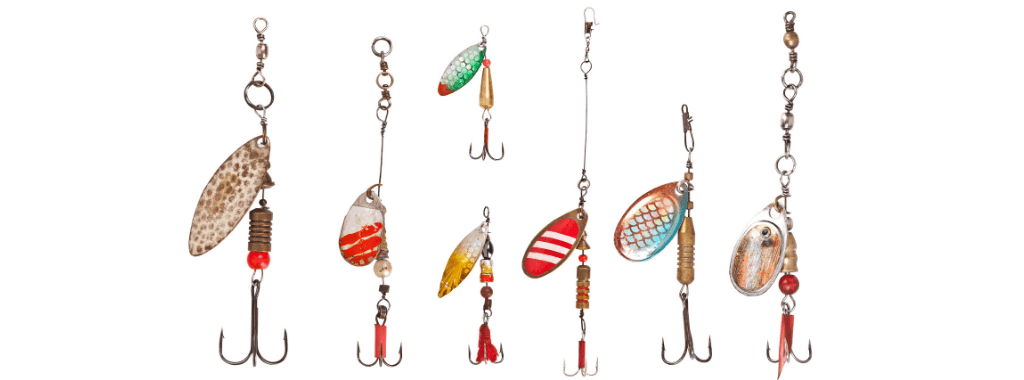
One good technique is to use a tiny baitfish lure with some silver or orange plastic. Of course, you can choose not to have any, but if you do, it should be no bigger than size 16-18 hooks, so smaller fish aren’t hooked too deep where they drown.
For bigger baits, double hook yourself two pieces of nightcrawlers or wax worms onto the line about 8 inches apart, so they look like legs for a frog. Leave just enough room between them for another piece of nightcrawlers or wax worms with skin to cover the gap and thread onto the line. The second piece should be slightly bigger than the first, so it’s invisible between the legs of the crawler that is on top.
For a nightcrawler leg rig, use size 12-16 hooks and thread one nightcrawler on each side, making sure to keep them straight and not overlapping.
You can use soft lures for perch, but smaller flies like #6 and #8 Woolly Buggers work best. As they mimic shiners, chubs, or other small baitfish that perch feed on. Hooks should be 2/0-3/0 streamer hooks depending on the size of the fly. They should also have a lead head to keep the fly underwater and not float too much. You can find ready-made flies or tie your own if you know how to do it.
Most lures will work well for this species. Since perch tends to hit almost anything in front of them. In the end, it is all about preference and trial and error. For best results, try to match the hatch (the fish’s natural prey) when fishing for perch or any species of gamefish. That will increase your odds of catching more fish rather than spending time trying out new lures that won’t work.
How to catch Perch Ice Fishing
Ice fishing for perch can be particularly fun since this type of fish schools together. When one perch bites, it’s likely that a whole host of perch is feeding nearby.
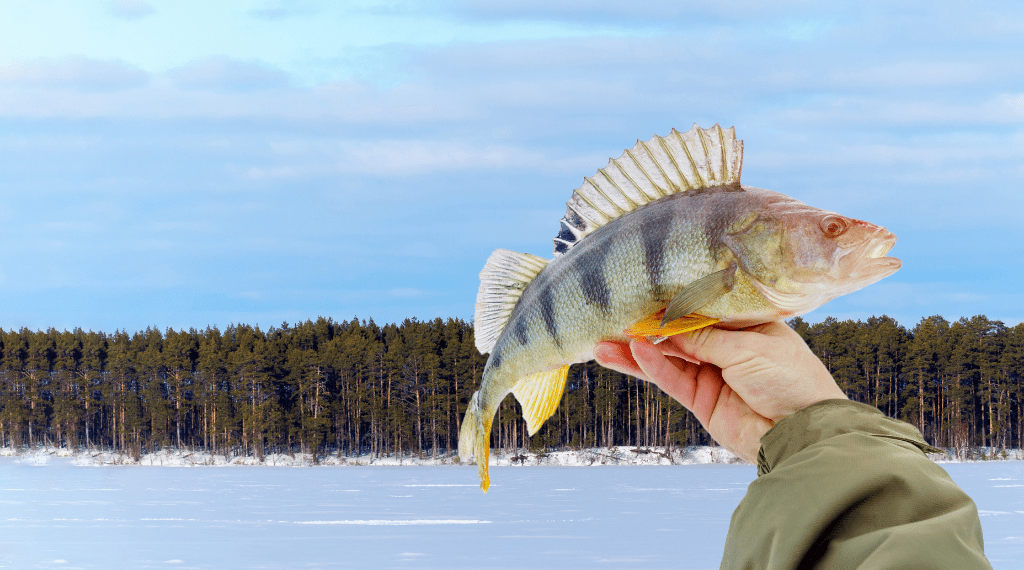
When the weather is frigid and the visibility is less than ideal, locating perch can take some time. These fish like to move around, which means that you should make at least several ice holes in preparation. If you want to make your search easier, a portable sonar will tell you if any fish are in the area. Underwater cameras and handheld GPS units can also aid in your search.
Perch tend to feed on freshwater shrimp and insects. You can mimic shrimp and insects by using an ice fishing jig that’s tipped with a basic wax worm. At first glance, this bait might seem small. But, I’ve found that it’s the perfect solution for catching small to medium-sized perch. If you want to target larger perch, then a different bait is best. Try pairing a flutter spoon with the head of a minnow. This bait will mimic a small baitfish. Since the lure is larger in size, it will cause the smaller perch to scurry away.
Start the process by gently dropping the bait until it hits the bottom. At this point, the bait should be picked up quickly before you lower the tip of your rod, which will serve to disturb the water and boost feeding activity. Slowly come up a few feet as you try to get a perch to bite.
If you intend to eat the perch that you catch, you can fish in any area. But, you should only fish for perch in shallower waters if you plan to release them. When releasing perch, it’s essential that you do so quickly to avoid the fish freezing. Make sure that you use bare hands when holding the fish, which will make it easier to remove the hook.
What Line to Use when Perch Fishing
You don’t need heavy gear when perch fishing. In fact, ultralight gear is best and makes it more fun. As perch are a smaller species if your fishing gear is too heavy you won’t feel their bite. Using a 4 to 6 lb monofilament line on an ultralight spinning reel paired with an ultralight fishing rod works best.
Keeping your gear light makes catching these small tasty panfish more challenging and enjoyable. Go too heavy on your gear and then it’s just like cracking a nut with a sledgehammer!
What is the Best Time to Catch Perch
Like many species, the best time of day to catch yellow perch is early morning and late evening. Perch are sight-based feeders and need light to be able to feed. They generally don’t feed during the night as it is too dark. So they become active again at first light. They use the low light conditions of early morning and late evening to find their prey and avoid becoming the prey of bigger species such as walleye.
You can catch perch all year round if you know what you are doing although spring and fall are the best perch seasons. As perch prefer cooler conditions the heat of mid-summer makes it more challenging. Once it gets too hot perch will become less active and seek deeper coolers waters.
Final Thoughts
Yellow Perch is a great tasting table fish and a blast to catch on ultra-light gear. They are plentiful are relatively easy to catch during spring and fall. This makes them one of the most popular panfish species in North America.
Now that you’re armed with our Tips & Techniques for how to catch perch I’m sure you’ll be landing a tasty specimen in no time.
I hope this article has improved your perch know-how, and I’d love to hear how you get on.

